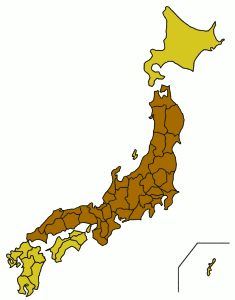Honshu
Honshū (本州) is the largest island of Japan, called the Mainland; it is south of Hokkaido across the Tsugaru Strait, north of Shikoku across the Inland Sea, and northeast of Kyushu across the Kanmon Strait. It is the seventh largest island, and the second most populous island in the world after Java (see the list of islands by size, population).
The island is roughly 1300 km long and ranges from 50 to 230 km wide, and its total area is 230,500 km², around 60% of the total area of Japan. It is larger than the island of Great Britain, and slightly larger than the state of Minnesota. Honshu has 5450 km of coastline.
Mountainous and volcanic, Honshu has frequent earthquakes (the Great Kantō earthquake heavily damaged Tokyo in September 1923); the highest peak is the active volcano Mount Fuji at 3,776 m. There are many rivers, including the Shinano River, Japan's longest. The climate is highly variable from the cool north to the subtropical south.
The population is 98,352,000 (as of 1990, in 1975 it was 89,101,702), concentrated in the available lowlands, notably in the Kanto plain where 25% of the total population reside in and around Tokyo and Yokohama. Other cities include Kyoto, Osaka, Kobe, Hiroshima, Sendai, and Nagoya. The island is nominally divided into five regions and contains 34 prefectures, including metropolitan Tokyo.
The regions are Chugoku (southern), Kansai (southern, above Chugoku), Chubu (central), Kanto (eastern), and Tohoku (northern).
Three-fourths of Japan's main, major, and modern cities are here on Honshu, including the 23 special wards of Tokyo, Yokohama, Osaka, Nagoya, Kobe, Kyoto, Akita, Sendai, Fukushima, Niigata, and Hiroshima. Cultural centers are also present, such as Kyoto (which is both modern and cultural), Nara, and Kamakura.
The island also includes important agricultural regions. Niigata is noted as an important producer of rice. The Kanto and Nobi plains produce rice and vegetables. Yamanashi is a major fruit-growing area, and Aomori is famous for its apples.
A mountain range runs along the length of Honshu from end to end. In addition to Mt. Fuji, the Japanese Alps are features of Honshu. The mountains are responsible for a marked difference in climate between the eastern or southern (Pacific or Inland Sea coast) side, and the western or northern (Sea of Japan coast) side.
The prefectures are:
- Chugoku — Hiroshima-ken, Okayama-ken, Shimane-ken, Tottori-ken, Yamaguchi-ken.
- Kansai — Hyogo-ken, Kyoto-fu, Mie-ken, Nara-ken, Osaka-fu, Shiga-ken, Wakayama-ken.
- Chubu — Aichi-ken, Fukui-ken, Gifu-ken, Ishikawa-ken, Nagano-ken, Niigata-ken, Toyama-ken, Shizuoka-ken, Yamanashi-ken.
- Kanto — Chiba-ken, Gunma-ken, Ibaraki-ken, Kanagawa-ken, Saitama-ken, Tochigi-ken, Tokyo-to.
- Tohoku — Akita-ken, Aomori-ken, Fukushima-ken, Iwate-ken, Miyagi-ken, Yamagata-ken.
Honshu is connected to the islands of Hokkaido, Kyushu and Shikoku by tunnels or bridges. Three new bridge systems have been built across the islands of the Inland Sea between Honshu and Shikoku (Akashi-Kaikyo Bridge and the Ohnaruto Bridge; Shin-Onomichi Bridge, Innoshima Bridge, Ikuchi Bridge, Tatara Bridge, Ohmishima Bridge, Hakata-Ohshima Bridges, and the Kurushima-Kaikyo Bridge; Shimotsui-Seto Bridge, Hitsuishijima Bridge, Iwakurojima Bridge, Yoshima Bridge, Kita Bisan-Seto Bridge, and the Minami Bisan-Seto Bridge), and the Seikan Tunnel connects Honshu with Hokkaido.

